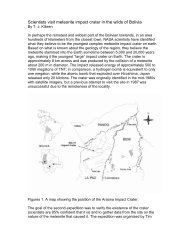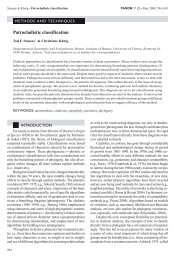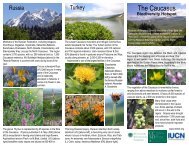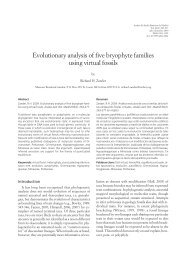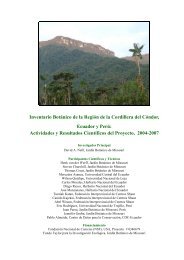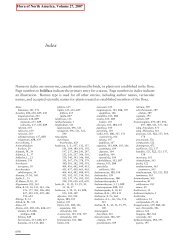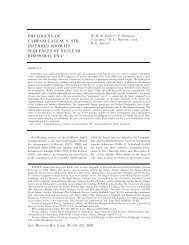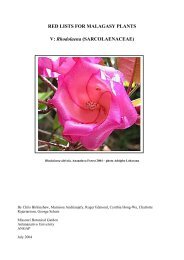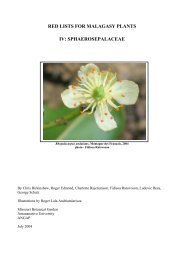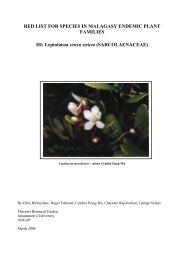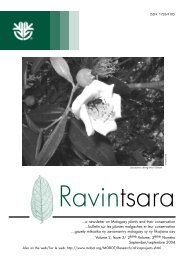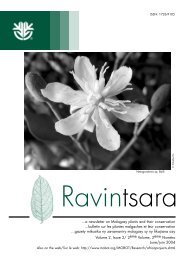re-evaluation of tortella - Missouri Botanical Garden
re-evaluation of tortella - Missouri Botanical Garden
re-evaluation of tortella - Missouri Botanical Garden
You also want an ePaper? Increase the reach of your titles
YUMPU automatically turns print PDFs into web optimized ePapers that Google loves.
two narrower inner perichaetial leaves whose laminae<br />
a<strong>re</strong> only somewhat narrower in the distal <strong>re</strong>gion, this<br />
character exaggerated by the p<strong>re</strong>sence <strong>of</strong> a longer mucro<br />
on most <strong>of</strong> the leaves <strong>of</strong> the elongate forms and by<br />
incurved distal margins. Elongate forms <strong>of</strong> T. humilis in<br />
North America sha<strong>re</strong> this characteristic as well.<br />
Occasionally the inner perichaetial leaves may be rather<br />
abruptly contracted above a mo<strong>re</strong> or less sheathing base,<br />
forming a narrow limb as in some leaves <strong>of</strong> the type <strong>of</strong><br />
T. japonica. However, this may also be seen in<br />
specimens <strong>of</strong> the short-leaved forms <strong>of</strong> T. humilis in<br />
North America as well and is conside<strong>re</strong>d he<strong>re</strong> to be part<br />
<strong>of</strong> the normal variation in the species. The perichaetial<br />
leaves <strong>of</strong> T. humilis in either long or short forms a<strong>re</strong><br />
conside<strong>re</strong>d he<strong>re</strong> to be undiffe<strong>re</strong>ntiated. Diffe<strong>re</strong>ntiated<br />
perichaetial leaves in the p<strong>re</strong>sent paper a<strong>re</strong> diffe<strong>re</strong>nt<br />
almost in kind from the stem leaves: primarily with a<br />
long, naked extension <strong>of</strong> the costa into an awn, such as<br />
occurs in T. tortuosa, T. inclinata var. inclinata, T.<br />
alpicola and T. fragilis.<br />
Saito also did not mention that the proximal<br />
cells interior to the proximal marginal cells gradually<br />
intergrade with the distal laminal cells, as is<br />
characteristic <strong>of</strong> Tortella humilis. In the elongated forms<br />
<strong>of</strong> North American material, especially in leaves toward<br />
the stem apex, the longer leaves have a mo<strong>re</strong><br />
distinctively V-shaped diffe<strong>re</strong>ntiation <strong>of</strong> the proximal<br />
cells. This is true in the longest leaves <strong>of</strong> intermediate<br />
American forms, such as in the outer perichaetial leaves,<br />
whe<strong>re</strong>as the intergradation is less distinct in shorter<br />
leaves, and me<strong>re</strong>ly U-shaped in very short-leaved<br />
material. Unfortunately, the variable Trichostomum<br />
tenuirost<strong>re</strong> also has a U-shaped diffe<strong>re</strong>ntiated proximal<br />
<strong>re</strong>gion very similar to specimens <strong>of</strong> both Tortella<br />
japonica and T. humilis, and, as in Saito's illustration,<br />
the diffe<strong>re</strong>ntiated proximal cells <strong>of</strong> Trichostomum<br />
tenuirost<strong>re</strong> do extend up the margins in various deg<strong>re</strong>es,<br />
just as in the genus Tortella. While Tortella japonica<br />
may <strong>of</strong>ten be tomentose, Trichostomum tenuirost<strong>re</strong> is<br />
never so.<br />
It is possible that descriptions <strong>of</strong> Tortella<br />
japonica by Saito (1975) and Noguchi (1988) include to<br />
some deg<strong>re</strong>e the characteristics <strong>of</strong> Trichostomum<br />
tenuirost<strong>re</strong> (= Oxystegus cylindricus (Brid.) Hilp.), a<br />
species which may be nearly indistinguishable from<br />
sterile specimens <strong>of</strong> the elongate-leaved Tortella<br />
humilis, and whose ranges and substrates overlap. In<br />
fertile specimens the best distinction is in the nearly<br />
always demonstrable autoicous bud in the latter species<br />
and its long-twisted peristomes in fruiting material. The<br />
former species is dioicous with comparatively shorte<strong>re</strong>ct<br />
teeth. In fact, the leaf shape <strong>of</strong> the plant illustrated<br />
for Trichostomum tenuirost<strong>re</strong> by Saito (1975) <strong>re</strong>sembles<br />
closely that <strong>of</strong> typical Tortella humilis, complete with<br />
the indication <strong>of</strong> the "U" shape <strong>of</strong> diffe<strong>re</strong>ntiated<br />
proximal cells. Trichostomum tenuirost<strong>re</strong> also has a<br />
mo<strong>re</strong> elongate stem (to 15 mm), usually mo<strong>re</strong> than twice<br />
the length <strong>of</strong> the stemless to short-stemmed Tortella<br />
japonica (to 7 mm).<br />
8<br />
Note that, although Saito (1975) indicated<br />
that Tortella japonica has a stem central strand and that<br />
Trichostomum tenuirost<strong>re</strong> does not, the latter species<br />
does, in many cases, have one, both in the Japanese<br />
material examined and as attributed to that species in<br />
the United States (Flowers 1973) and in Europe (Hilpert<br />
1933).<br />
When both species a<strong>re</strong> sterile, they may be<br />
distinguished by the <strong>re</strong>latively shorter stem <strong>of</strong> Tortella<br />
humilis (to 7 mm), its rosulate habit, its variable<br />
tomentum and its leaf edge firm and orderly (<strong>re</strong>gular),<br />
as opposed to the mo<strong>re</strong> elongate stem <strong>of</strong> Trichostomum<br />
tenuirost<strong>re</strong> (to 15 mm), the leaves mo<strong>re</strong> loosely<br />
disposed on the stem, its lack <strong>of</strong> tomentum and its leaf<br />
edge <strong>of</strong>ten showing a scalloping or lobing edge<br />
indicating zones <strong>of</strong> weakness; the<strong>re</strong> is g<strong>re</strong>ater fragility<br />
<strong>of</strong> the leaf lamina and occasional obscu<strong>re</strong> and distant<br />
marginal teeth in the distal leaf <strong>re</strong>gion. Also a<br />
distinctive V-shaped proximal cell <strong>re</strong>gion <strong>of</strong> Tortella<br />
humilis may <strong>of</strong>ten be successfully found on the largest<br />
leaves, whe<strong>re</strong>as in Trichostomum tenuirost<strong>re</strong> this will<br />
not occur.<br />
The type <strong>of</strong> Tortella japonica <strong>re</strong>p<strong>re</strong>sents a large<br />
statu<strong>re</strong> that even the ordinary <strong>re</strong>p<strong>re</strong>sentative specimens<br />
in Japan do not approach, yet the type material (at PC)<br />
has the same leaf shape as ordinary North American<br />
material. Such large statu<strong>re</strong> was duplicated in a<br />
specimen from Ontario, Canada from the north sho<strong>re</strong> <strong>of</strong><br />
Lake Huron, possessing a proliferation <strong>of</strong> branches, four<br />
<strong>of</strong> which supported fertile perichaetia with a long stem<br />
to 7 mm, the longest among variants on the margins <strong>of</strong><br />
the North American floral distribution.<br />
In Zander's (1994d) description <strong>of</strong> Tortella<br />
japonica from Mexico, he noted the "shiny upper part <strong>of</strong><br />
the costa, owing to smooth, elongate cells on the ventral<br />
surface" contributed to the distinctiveness <strong>of</strong> the<br />
Mexican specimens examined. However, he also<br />
described the plants as having a "costa cove<strong>re</strong>d on the<br />
adaxial surface in the middle <strong>of</strong> the leaf by quadrate,<br />
papillose cells." In typical short-leaved Tortella humilis,<br />
the quadrate cells on the adaxial surface <strong>of</strong> the costa<br />
disappear toward the apex <strong>of</strong> the leaf—but this is<br />
inconspicuous. In leaves significantly mo<strong>re</strong> elongate,<br />
this <strong>re</strong>gion <strong>of</strong> elongate, smooth cells is also longer and<br />
mo<strong>re</strong> conspicuous. The same comparison may be made<br />
between short and very long leaves <strong>of</strong> Tortella tortuosa.<br />
Clearly Tortella humilis, a widesp<strong>re</strong>ad species<br />
in the Northern and possibly Southern Hemisphe<strong>re</strong>,<br />
shows a plasticity not p<strong>re</strong>viously <strong>re</strong>cognized. In North<br />
America, it grades from short, broad plants in the<br />
northcentral and eastern distribution, becoming mo<strong>re</strong><br />
gracile on its margins, especially to the south. Indeed,<br />
upon <strong>re</strong>view <strong>of</strong> examples at BUF used by Zander for the<br />
Moss Flora <strong>of</strong> Mexico, nearly all <strong>of</strong> the Mexican<br />
material <strong>of</strong> Tortella humilis is a "Tortella japonica"<br />
facies similar to plants from Texas and the southern<br />
American states. All other material seen in a small<br />
sample <strong>of</strong> Mexican specimens at BUF, <strong>re</strong>p<strong>re</strong>sents<br />
minute plants that a<strong>re</strong> sterile, or a<strong>re</strong> possibly not<br />
satisfactorily named.





